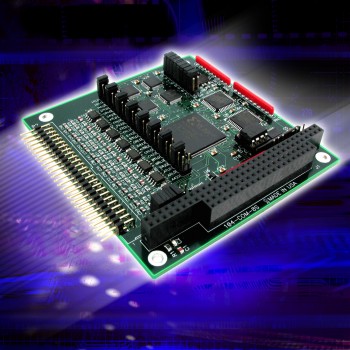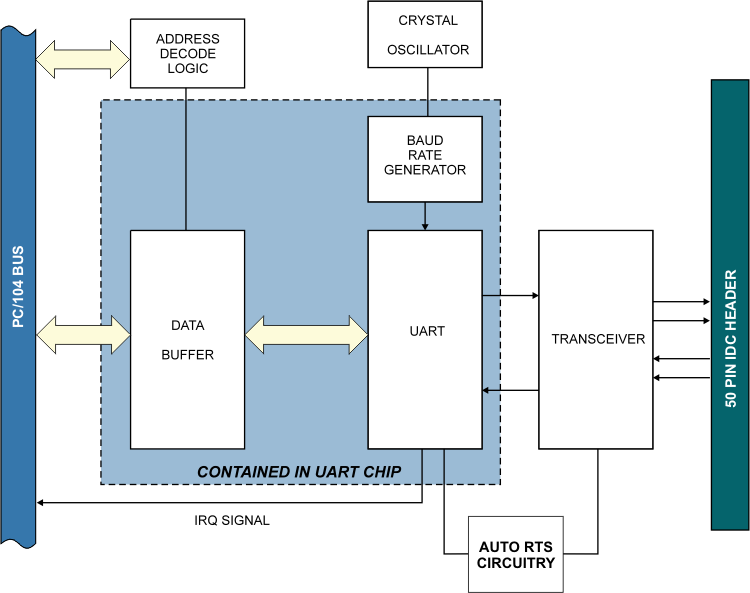104-COM-8S Series
PC/104 Eight, Four, and Two-Port RS-422/485 Serial Communication
Features
- 8, 4, or 2 independent asynchronous serial COM ports
- Field selectable RS-422 and RS-485, independent for each port
- Auto-RTS feature makes half-duplex RS-485 communications effortless
- Speeds up to 921.6K
- Fixed bias and jumper selectable termination provided on each transmit and receive channel simplifies cabling
- Programmable individual non-volatile base addresses and IRQs simplifies installation
- Low power required: +5VDC at 80 mA typical
- Operates as a standard COM port in all operating systems
- Designed, made, supported, and manufactured in the USA

Factory Options: (call for pricing and availability)
- 16850 UARTs with 128-byte FIFO
- 0 to 70°C and -40 to +85°C versions available
- RoHS Available. Please contact us for ordering information
Common applications include POS, gaming systems, machine monitoring, military and highdensity networking.
Type 16550 UARTS are used as the asynchronous communication elements. These include 16-byte transmit/receive FIFO buffers to protect against lost data in multitasking systems while maintaining 100% compatibility with the original IBM serial port.
A crystal oscillator located on the board permits precise baud rate capability up to 115,200. Higher speeds, up to 921.6K, are achieved by installing a jumper on the board. The driver/receivers used, type SN75176, are capable of driving long communication lines at high baud rates. They can drive up to ±60 mA on balanced lines and receive inputs as low as 200 mV differential signal superimposed on common mode noise of +12 to -7V. In case of communication conflict, the driver/receivers feature thermal shutdown.
This board may be operated in two modes. In the Default Mode, the base address for the board is selected by jumpers and all of the channel addresses are sequential. Because it is sometimes difficult to find a large enough block of addresses to permit this approach, an alternative is provided. The addresses and interrupts of the individual channels may be stored in non volatile memory on the board and loaded into programmed logic when the board is initially powered. Individual interrupts for each channel are programmed into the non-volatile memory in both modes.
AUTO TRANSCEIVER CONTROL
UTILITY SOFTWARE
Downloads
Available Reference Manuals
- View / Download the 104-COM-8S Manual (.PDF)
- View / Download the Software Reference Manual (.PDF)
Available Software Downloads
Available Datasheets
- View / Download the 104-COM-8S Data Sheet (.PDF)
Drivers and Downloads
Full list of available Downloads: Software Packages, Drivers, Manuals, and other documents
Custom Software
ACCES also offers Custom Software Services for our products. Our prices are unbelievably low, often as inexpensive as free! If you need something tweaked to support your needs, or an entire enterprise application developed from scratch, it is definitely worth your time to inquire with us, first.
Further information about available ACCES Software:
- Redistributing Windows Drivers
- A list of ACCES drivers and the files that compose them under different versions of Windows, so you can easily redistribute ACCES cards and drivers.
Specifications

Communications Interface
- I/O Connections: Via a 50 pin IDC type right angle connector. There are four pins per port plus common grounds.
- Character Length: 5,6,7, or 8 bits
- Parity: Even, odd, or none
- Stop Interval: 1, 1.5, or 2 bits
- Serial Data Rates: Up to 115.2K baud, asynchronous. A faster range of rates, up to 921.6K, is achieved by jumper selection.
- Multidrop: Compatible with RS-485 specifications. Up to 32 drivers and receivers allowed on line. Driver/Receivers used are type 75ALS180.
- Compatible with RS-422 specifications. Up to ten receivers allowed on line.
- Address: ISA BUS address is set by jumpers on the board. A “Default” jumper determines whether the channel addresses are sequential or loaded from nonvolatile memory on the board.
- Interrupts: Individual IRQs for each channel are stored onboard in non-volatile memory.
- Receiver Input Sensitivity: ±200 mV differential input
- Common Mode Voltage Range: +12V to -7V
- Transmitter Output Drive Capability: 60 mA with thermal shutdown. Jumper selectable terminations for input and output, by channel, are provided.
Environmental
- Operating Temperature: 0 to 70°C, (-40 to +85°C Optional)
- Storage Temperature Range: -50 to +120°C
- Humidity: 5% to 95% RH, non-condensing
- Power Required: +5 VDC at 80 mA typical, all outputs open

CE testing & approval must be done at the system level, in the designed enclosure, and is not done on individual boards.
| Model | Price (USD) |
|---|---|
| 104-COM-8S | 219.00 |
| 104-COM-4S | 149.00 |
| 104-COM-2S | 119.00 |